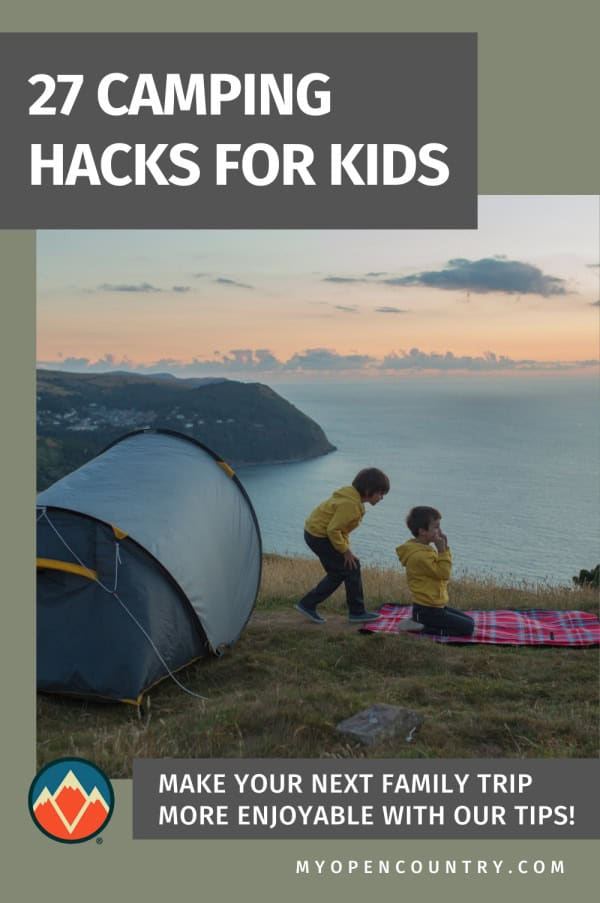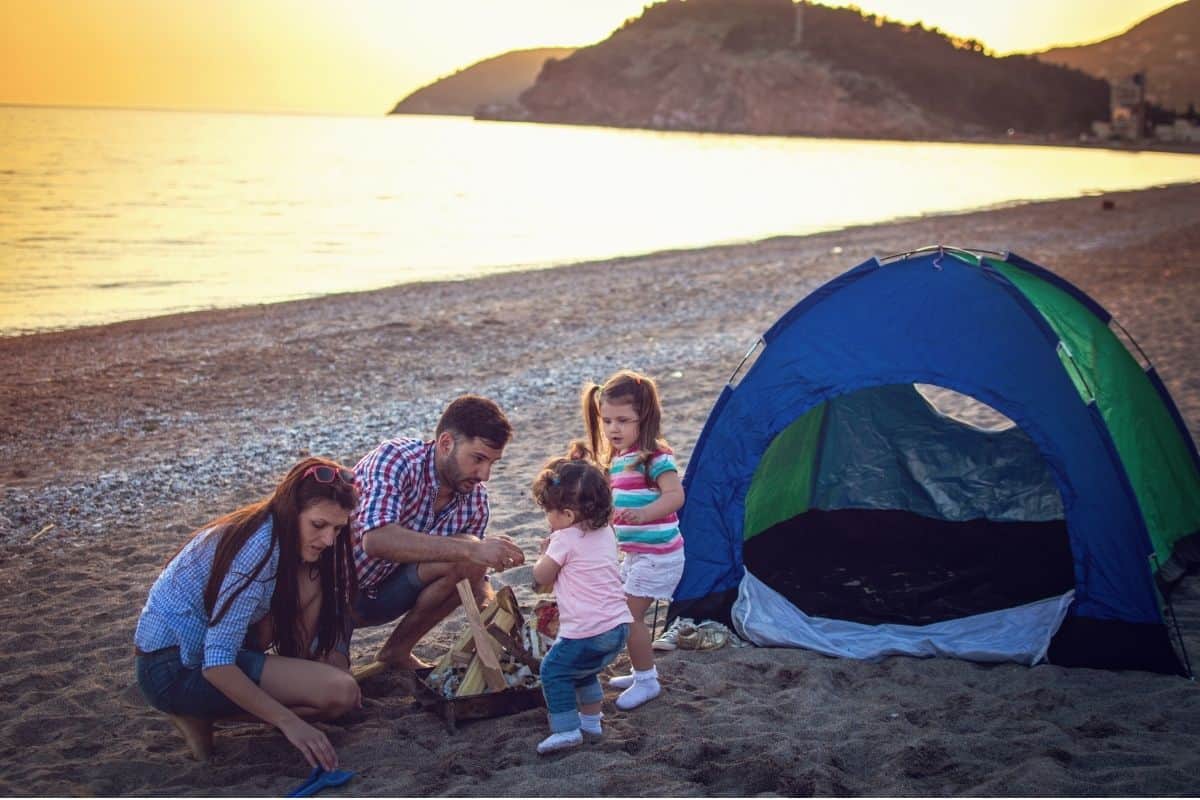In recent years, several studies have revealed that the current generation of youngsters are spending more time in front of devices and less time playing outside in the fresh air…all, of course, to the detriment of their psychological and physical wellbeing. So, how do you inspire your child to get outside and explore the natural world around them? Take them camping!
Camping is a great way to get away from everyday life, go someplace new, and teach your kid skills and lessons that may be valuable to them later in life, or at least provide a much-needed break from those all-consuming screens.
Our comprehensive guide will let you take the stress out of your camping trips and start camping with your kids with confidence. You may find yourself having a great time too!
Table of Contents
- Key Takeaways
- Why Take a Camping Trip with Your Kids?
- Acclimatizing Your Kids to Camping: 6 Tips
- Tent Camping With Toddlers, Kids, and Teens: Preparing for Your Trip, Step by Step
- What to Do When Camping
- Spending Time Outdoors & Finding Fun Activities
- Do’s and Don’ts for a Camping Trip With Kids
- Fun Times With the Whole Family!
Save for later! ⤵️
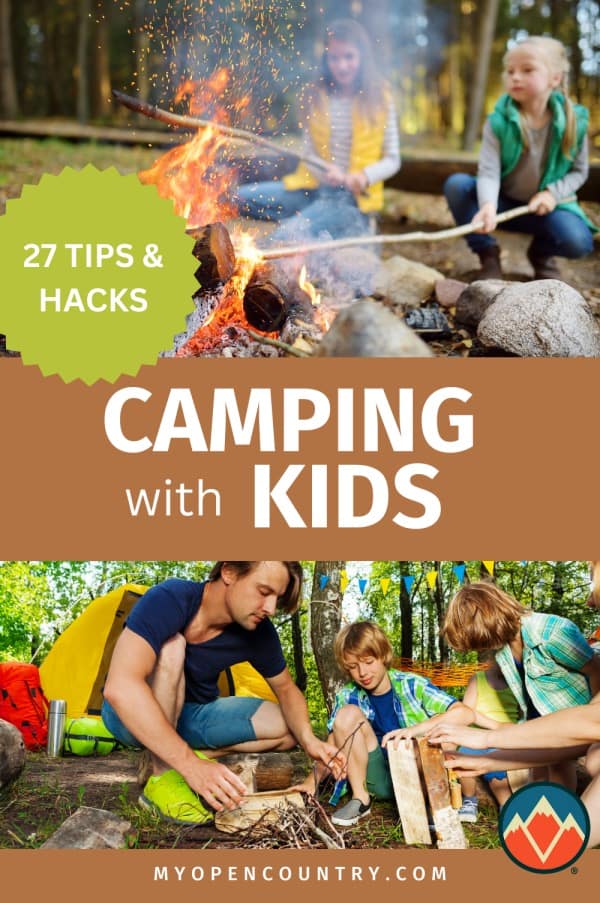
Why Take a Camping Trip with Your Kids?
Nowadays, there’s a lot of fun to be had by staying at home. Between computers, TVs, and smartphones, kids young enough to control their movement have access to a literal world of entertainment.
That said, there are some things you just can’t learn from a screen – and a family camping experience is one of the best ways to show your kids the world beyond technology. Besides, kids tend to love camping – as long as you do it right.
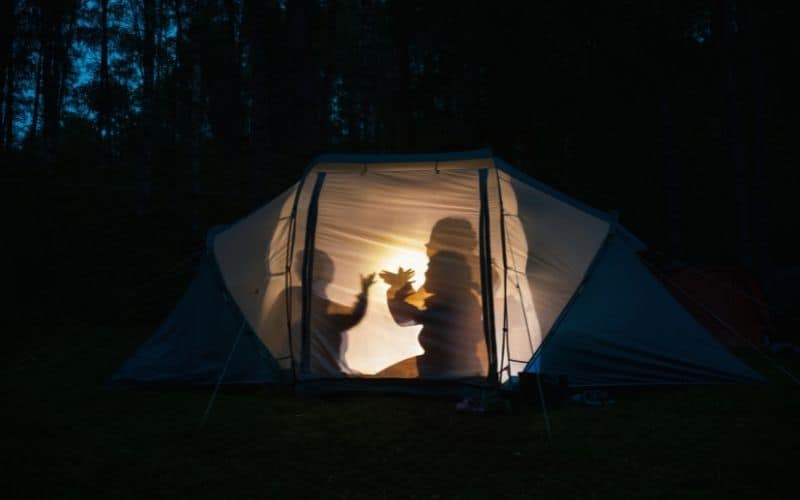
Camping offers toddlers sights, sounds, and experiences they simply can’t get at home. Many campsites are also located in family-friendly areas with toddler-friendly activities like interpretive trails, petting zoos, mini-golf, and paddling pools. Camping also offers a great way to teach toddlers new vocab, using all the new visuals in your vicinity to introduce new words.
For older kids or pre-teens, camping turns their ideas and dreams into reality. This could be having a private den of their own, getting to stay up late and tell stories, exploring nature, or getting to play Indiana Jones, Katniss Everdeen, or maybe Dora the Explorer for a few days!
For teenagers, camping offers more significant challenges. They’ll learn how to be independent and self-reliant, both of which can aid their development towards becoming a fully-fledged, confident, and responsible adult.
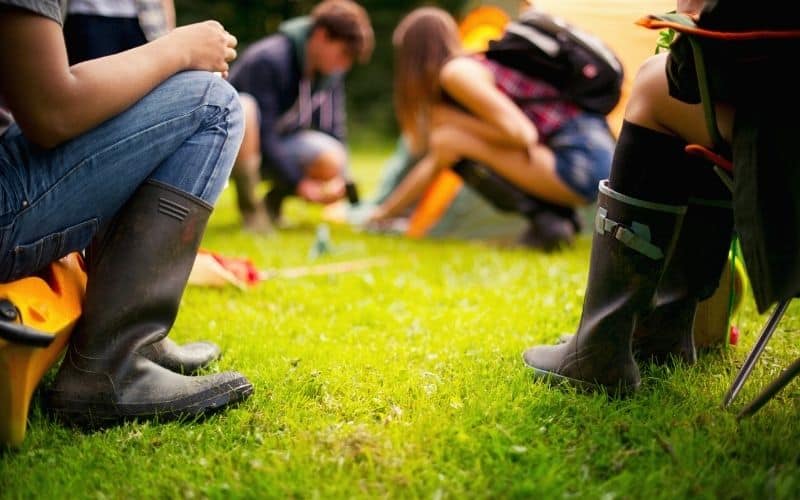
Of course, your kid/kids aren’t the only ones who benefit from camping – you will, too!
Tent camping is a great way to get away from the pressure of everyday life and spend some time with your family. No television, no news bombardment, and no social media – though you should have a phone (normally kept off) for emergency calls or checking in. On top of this, science has shown there are multiple health benefits of being outside in nature.
As a bonus, a family camping trip is relatively cheap once you’ve obtained the essential camp gear. The right set can last for years and allow you to stay at places all around the country.
What Skills Can My Kids Learn on a Camping Trip?
There are many important skills kids can learn from camping.
First and foremost is wilderness safety. This covers everything from how to create a fire pit to how to recognize and respect wild animals. Parents can also teach their kids to recognize the signs of sickness or injury in wildlife, either of which can make them far more dangerous than usual.
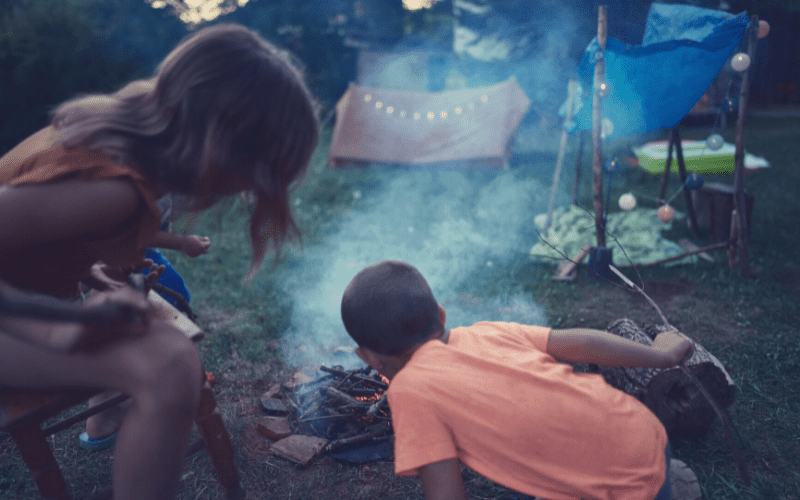
Next, you can educate them on wilderness survival. This includes foraging for food, avoiding poisonous plants like poison ivy, and safely navigating without the help of GPS. It’s never a bad idea to know how to get where you’re going without electronic support.
Finally, your kids can learn various life skills. If you just show them how to tie a knot, for example, they may not remember how to do it later. On the other hand, if they regularly use several essential camping knots to set up a tent, hammock, or drying line, there’s a much higher chance they’ll retain that skill when they need it.
Many camper skills are useful in other areas – camping just happens to be a great place to teach them to your kid.
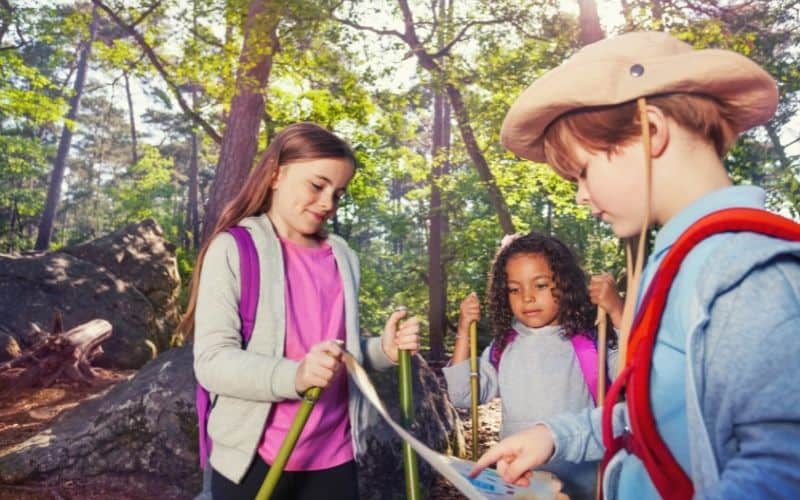
Acclimatizing Your Kids to Camping: 6 Tips
Heading on a camping trip with your kids is fun, but if you suddenly drive your kiddos out to the wilds one day when they have spent their whole life in a city, and without warning or preparation, they may feel lost and have no idea what to do. A little acclimatization, then, is key.
There are a couple of things you should do several weeks before your first camping trip with your kid:
1. Create a List
Early in the planning process, you should create a checklist” that itemizes everything you’ll need to bring. Why so early? Well, speaking from experience, your original list will probably lack roughly 50% of the items that will be on there by the end!
Start with the essentials (i.e. those things the trip would be a disaster without), then add the good-to-haves and anything else as you go.
2. Practice Inside
If you have young kids, start by creating a makeshift tent somewhere in your home and “camp” with your kids there. If you have enough space, move this ‘tent’ with their sleeping gear inside around the house each night.
This will help your kids get used to sleeping in different spaces. You may even need to start with them sleeping in a sleeping bag in their own bed because sleeping bags can take some getting used to. If you have teenagers, you can skip right to the next step.
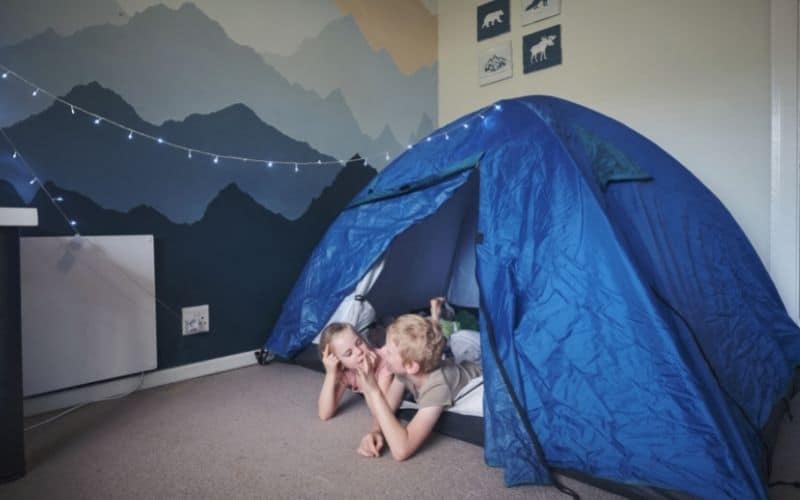
3. Practice Outside
Set up a small campsite in your backyard to practice camping. If you’re not sure how your kids are going to react, consider borrowing a tent from a friend instead of buying one. This will help your kids get used to the idea of sleeping outside. This has the added benefit of helping you figure out anything they need, like a certain pillow or stuffed animal.
4. Take a Day Trip
Before you stay anywhere overnight, go on some family-friendly hikes for a morning/afternoon or day, perhaps to a lake or national park.
Be sure to leave technology behind – they shouldn’t have any access to it on the day of the trip until you’re all back home.
If you have time, bring along a tent and sleeping bag and let your kid see how tents are pitched and how it feels to sleep in a bag instead of a bed.
5. Measure Your Kids’ Skills
Some kids are better at camping than others. If you’ve never been camping yourself, you may want to look for a site with lots of features and amenities.
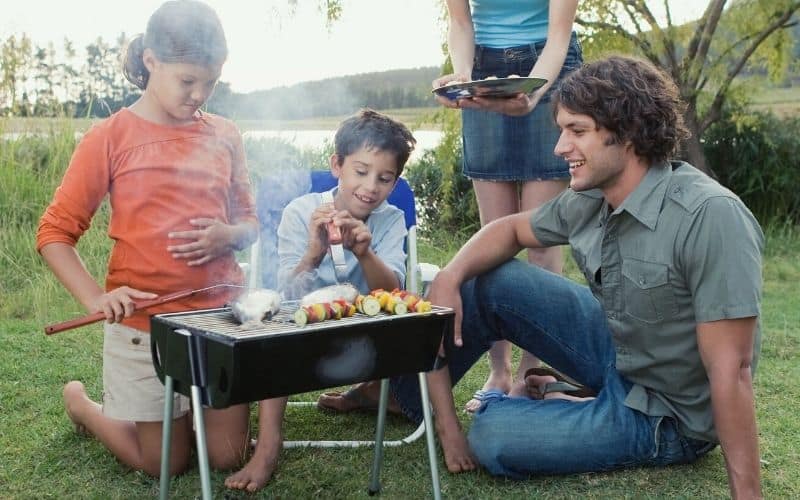
Even if you’re an expert, remember that your kids don’t have your skills – and you should pick a site that’s challenging, but not too much for them to handle.
6. Talk to Your Kid About Camping
Kiddos like to feel involved, so it’s important to talk to them about what camping is and why you want to do it with them. Be sure to address any concerns they raise. Kids often think of things you didn’t because they have a completely different point of view – and if you don’t address their worries, they’re not going to have fun.
Tent Camping With Toddlers, Kids, and Teens: Preparing for Your Trip, Step by Step
Preparation is one of the most important parts of camping – and one of the best ways of getting your kids to get involved. Here’s how it’s done:
Step 1: Ask for Input
Talk to your kid about the trip and ask them what they want to do or see along the way. They should feel like their input is important. If they want to see a waterfall, find a campground with a waterfall. If they want to make s’mores, bring the ingredients for that. If they have any thoughts on sleeping arrangements, take these into account.
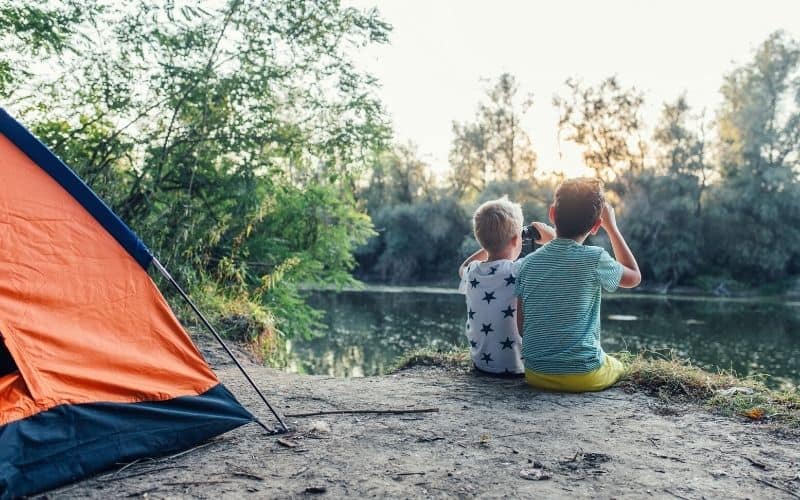
At every stage, they should feel like their decisions matter – this is important groundwork for the safety lessons they’ll learn later on.
Step 2: Pack
Leave the packing to your kids. Make a list of things your children should pack, but have them do the work. You should double-check it before you leave. Putting them in charge of packing is another great way to teach them responsibility.
Step 3: Teach Organization Skills
Having matching bags might look great in photos, but it’s a mess in practice. Instead, use different-colored bags for each kid and teach them to return things to their bag as soon as they’re done with it. This will help stop them from losing things at the campsite.
Step 4: Bring a Toy
While you shouldn’t bring electronic gadgets, it’s a good idea to bring toys your children are familiar with. Stuffed animals are an ideal choice for this (as long as they remain somewhere clean, of course). This creates an emotional connection between camping and their safe space.
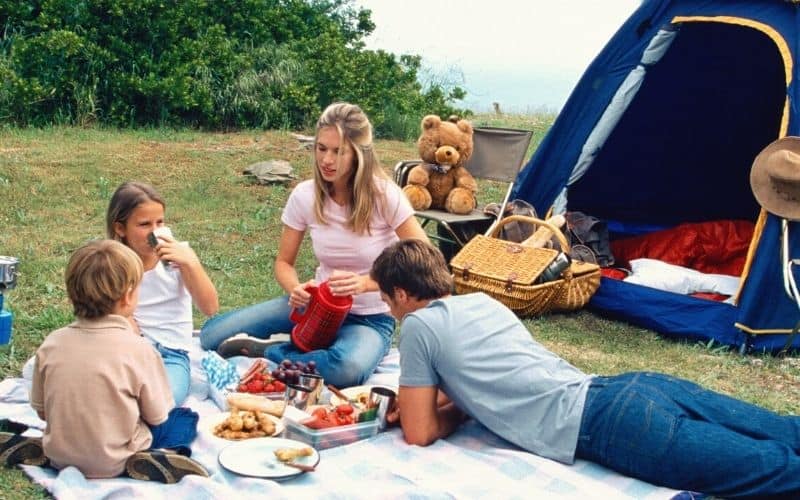
Step 5: Invite Other People
If possible, invite other families along. Children tend to do better if they have playmates their own age, and having more adults around means you can take turns keeping an eye on them.
Step 6: Check Campsite Restrictions
Many campsites have restrictions about fire, pets, and so on. It’s your job to vet the sites and come up with a list of acceptable locations. That said, once you do, let your kid decide from the list which site you’ll visit.
Step 7: Find Nearby Attractions
Theme parks, historical sites, or geological attractions are handy fallbacks for wet-weather days or if your campgrounds amenities and facilities aren’t cutting it for your kid.
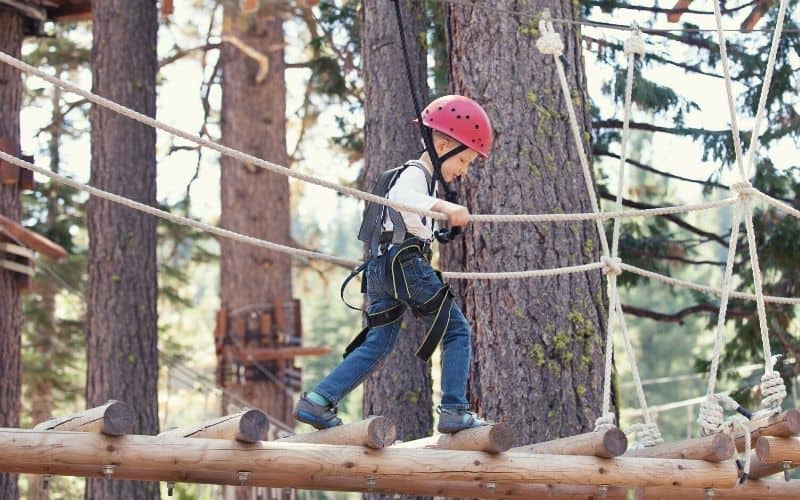
Step 8: Teach the Buddy System
This can help your children avoid getting lost. Be sure to set some rules for the buddy system, such as “you can only buddy up with an adult.” This will ensure they don’t feel free to wander wherever they want just because their playmate is with them.
Step 9: Reinforce the Experience
Your child should have the opportunity to listen to (or talk with) other people before you go. If possible, these people should genuinely enjoy camping themselves – but don’t be afraid to ask them to bluff a bit if you really need to.
This will help reinforce the idea that camping is fun, not just a bad experience where children are dragged away from everything they like.
Step 10: Have a ‘Plan B’
Sometimes, mother nature doesn’t cooperate with your camping plans. Have an alternative schedule ready, and again let your kids plan and get involved too so they feel like they have some control.
What to Do When Camping
There are quite a few things you’ll need to do when at the campground with your child or children. Fortunately, most of these will quickly become a habit.
While At Camp
Establishing a new routine is critical to a successful experience:
1. Stay Positive
Everything is different and usually less convenient when you’re camping. Be positive and upbeat – if you start acting like things are a chore, your kids will notice and respond accordingly.
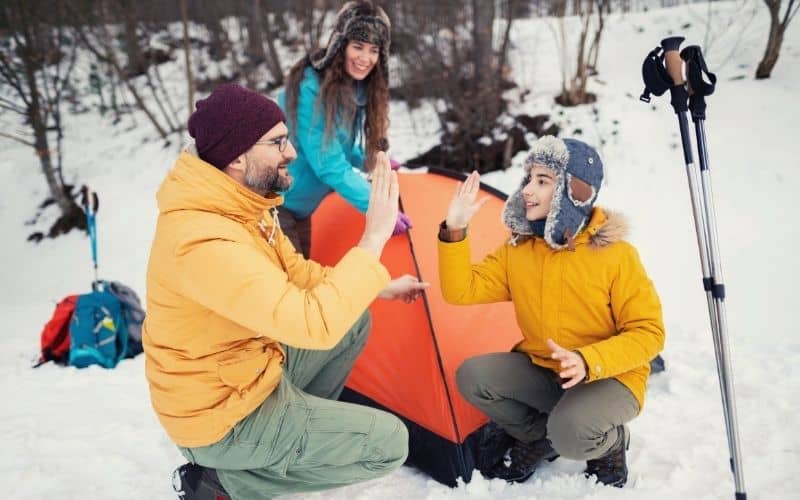
2. Locate the Important Things
Find the bathrooms and emergency stations, where available, as soon as you can. Your kids will probably need the former after a long ride anyway.
3. Organize
As you unpack, keep things organized. Everything should remain in the same place as much as possible – this will help you avoid losing stuff. Consider writing a list of what is in each container and color-coding each one for easy access.
4. Orient Yourselves
Once you’ve started to set things up, talk with your kids and find landmarks you can use to remember your position. Children should always know how to locate their camp from within the campgrounds.
5. Set Boundaries
Determine the edges of your campsite: This is a vital part of helping your kids feel established. Once they understand that there are limits to the campground’s size, they’ll mentally separate things into “my camp” and “not my camp”. Once they recognize the campsite as “theirs”, they’ll be more likely to remember where it is.
6. Assign Meaningful Chores
Most children prefer to be involved when camps are being set up. Give them some important jobs to do, and give them praise when they’re done.
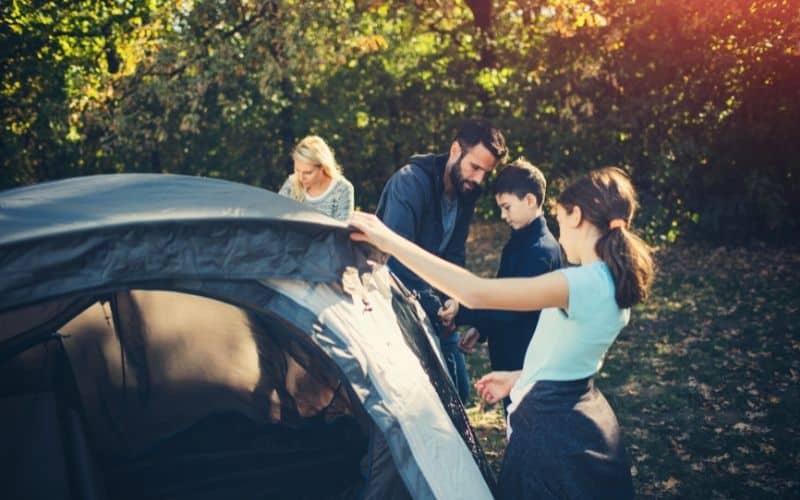
7. Provide Safety Gear
Children should have lights and whistles, preferably attached to their belt loops or another location where they won’t easily come off. Teach them to blow the whistle if they get separated – this will help you realize they’re gone so you can go get them.
8. Ask About Animals
Talk to park rangers or camp staff about the local wildlife. You’ll need to be proactive about learning this, then teach your kids the same information.
Tips for Fun in the Outdoors
There are some additional factors to consider while you’re outdoors with your kids – especially if you’re heading away from your tents.
1. Bring Pocket Guidebooks
Kids love hearing cool facts so why not indulge them by being a walking encyclopedia! Unless you are already well-versed in all things nature, bring along a few pocket guide books that relate to your children’s interests.
2. Be Curious
You have options as regards activities that will kindle your kid’s curiosity. You can examine plants, check out bugs, search for rocks, or simply look up at the sky. A field guide can help you identify the plants, animals, and stones native to the area. Express interest in the things that interest your kids – this will help them feel confident about exploring.
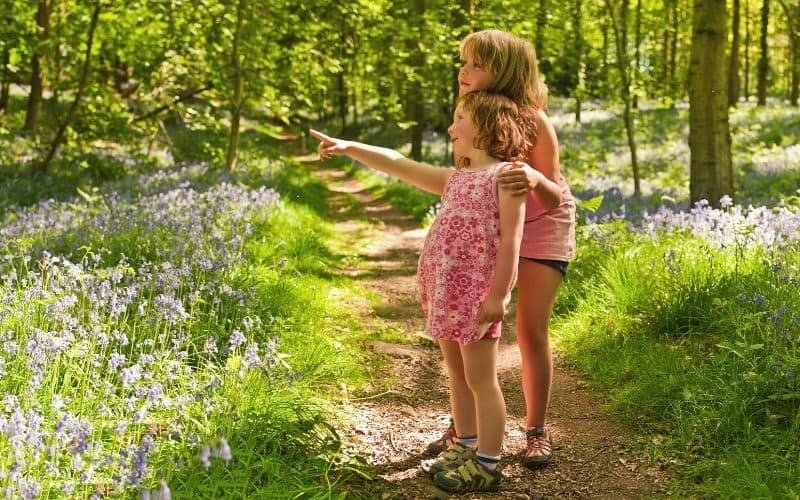
3. Ditch the Schedule
While you should have a general plan for the day, try to avoid setting exact times for things. If your kids seem more interested in one thing, do more of that. If they seem bored by something else, cut that short and move on. As before, they should feel like their opinions matter.
4. Lengthen the Leash
We get it, it’s daunting to let your kid run wild and free in an unfamiliar environment. Letting them get the odd grazed knee or mud-stained shirt, however, will teach them valuable lessons and allow them to explore the environment the way they choose.
5. Geocaching?
Geocaching, simply put, is like a large-scale, modern-day treasure hunt. Kids love it. Adults love it. Need we say more?
Camp Cooking
Cooking is one of the best parts of camping – you get to enjoy what you worked on! Let’s start with setting up a proper cooking site, then take a look at some easy recipes.
https://www.instagram.com/p/BdzN6xznJGH/?utm_source=ig_embed
Setting Up Your Camp Kitchen
- Don’t cook inside your tent: Most camp cooking involves a fire or grill, and tents are not designed to handle the heat or the smoke.
- Start with your shelter: A good cooking shelter includes an overhead rain fly or tarp and a windbreak. This isn’t necessary if you’re using an open fire pit, but we don’t recommend that for longer trips. Similarly, don’t put a tarp over the fire pit if you have both. Alternatively, you could invest in an outdoor pop-up canopy.
- Set up your table: This is easy to get wrong because the table should be as flat as possible – and many campgrounds aren’t flat. Ideally, you’ll have a table where you can adjust each leg’s height individually. Don’t have a table? Set up at nearby picnic tables instead!
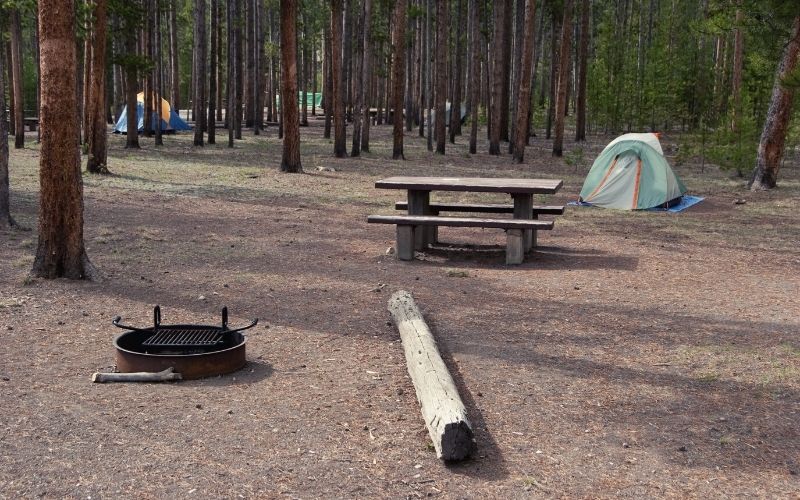
- Set up your camp stove: Most families do better with a two-element stove, rather than a single one. Make sure the gas cylinder – if you’re using one – isn’t located anywhere people are likely to bump into it.
- Decide how to use your fire pit: Most people prefer to set a stand over the fire and hang a pot or roast over it. Guidelines for fire pits can vary. Some campgrounds (especially in national or state parks) only allow them in certain areas, while others may insist the fire pit itself be hung off the ground.
- Use a kitchen storer: These bags are specially designed to hold cups, plates, utensils, and other kitchen supplies in one easy-to-manage pack. Having a single place to find and return things significantly reduces the likelihood of losing track of them.
- Set up your coolboxes: Try to avoid coolboxes that require electric hookups, as this will restrict where you can go. Instead, bring one or two boxes (with plenty of refreezing ice packs) for the things you need to keep cold. It also helps to preserve the prime real estate space in your cooler box by portioning up different food stuffs so you only carry what you need.
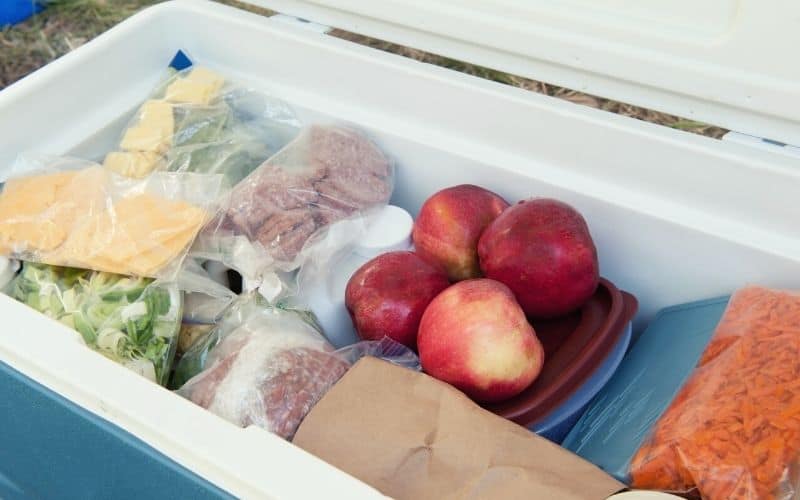
- Figure out how you’ll wash things: Some campsites have facilities for washing dishes, but in many cases, they’re too far away to be convenient. Instead, bring a collapsible bowl and some dish soap, such as biodegradable camp soap, then add water at the campsite.
As you continue camping, you’ll figure out what works best for your family and the types of campgrounds you prefer to visit. Don’t be afraid to experiment a little, but do have a backup plan just in case.
Recipes
Here are some of our favorite camping recipes – and best of all, they’re easy for kids to get involved with! Check out this article for 21 camping food ideas including our favorite campfire hot dogs!
Campfire Potato Wedges
This delicious snack is easy to make and your kids will love it!
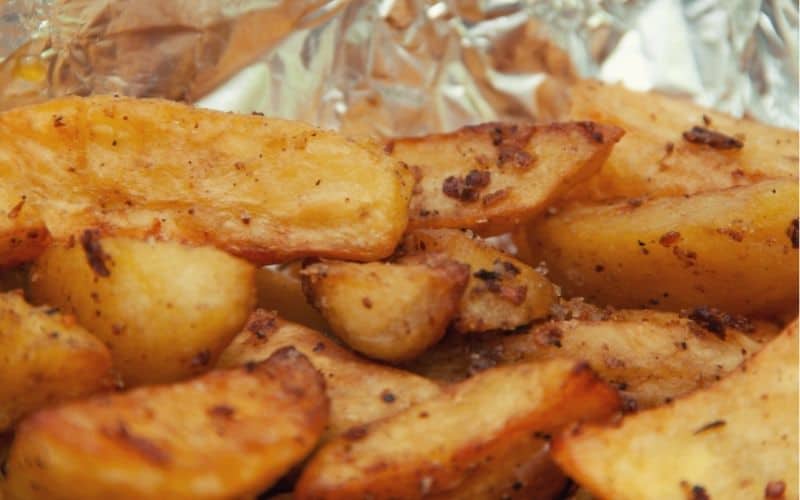
Ingredients:
- Potatoes
- Oil
- Seasonings (peppers, salt, herbs, etc., to taste)
- A barbeque or hot embers from your fire
Equipment:
- Aluminum foil
- Colander and Bowl
- Cutting surface
- Hot gloves
- Knife
In most cases, the potatoes will be done in about 40 minutes. Be sure to turn them every 10 minutes or so using your gloves, and start checking them for doneness after half an hour. Don’t put too many potatoes in one container as they won’t cook very well if the heat gets spread out too much.
Campfire Pizza
Most kids love pizza and mentioning this recipe to them is one of the best ways of getting them excited about your camping adventure.
https://www.instagram.com/p/BVvjh5Ijv4L/?utm_source=ig_embed
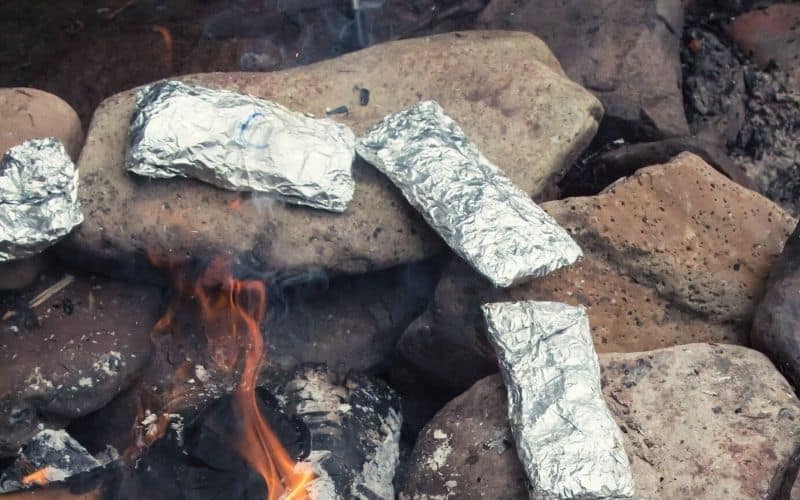
Ingredients:
- Pita bread (make sure you can split it to create a pocket)
- Spaghetti or pizza sauce (1 jar/can is usually enough)
- Grated cheese (preferably fresh, but store-bought and non-refrigerated will suffice if necessary)
- Toppings (pineapple, corn, cooked chicken, etc.)
Avoid raw ingredients, such as uncooked chicken.
Equipment:
- Knife
- Spoon
- Aluminum Foil
- Campfire
Each pizza should be fully heated in 1-2 minutes per side. The cheese should be visibly melted, while the pita itself should look toasted, but not burnt.
S’mores
The eternal favorite – and with good reason. This is a fun, simple, and delicious treat for your kids. You’ll need graham crackers, chocolate, and large marshmallows. Using some long, clean sticks, preferably sanitary ones you brought from home, heat the marshmallows over the fire until they’re golden brown.
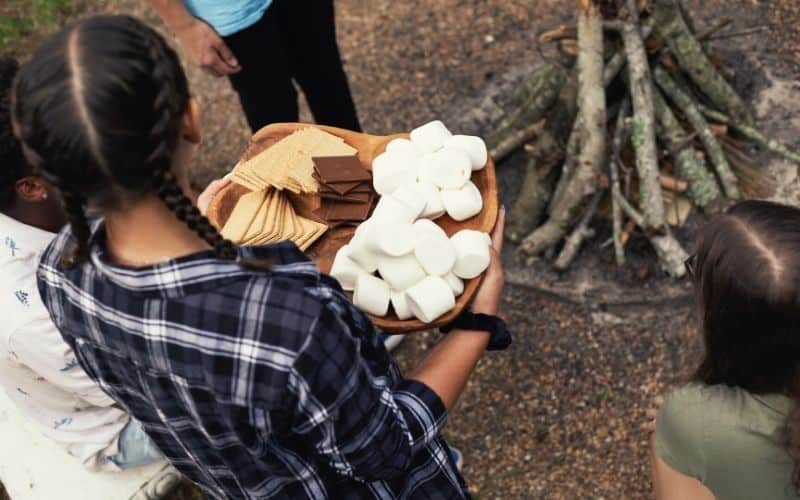
While that’s happening, break the graham crackers and set chunks of chocolate on one side. When the marshmallow is done, plop it on the open side, then fold them together and wait a minute or two.
While most people like milk chocolate, other people prefer to try things like peanut butter cups, chocolate icing, or other chocolate flavors.
Spending Time Outdoors & Finding Fun Activities
There are many types of activities to enjoy at campsites, from guided nature walks and bird-watching to geocaching and river rafting. They’re also great places for your little ones to meet other kids and get socializing.
Save for later! ⤵️
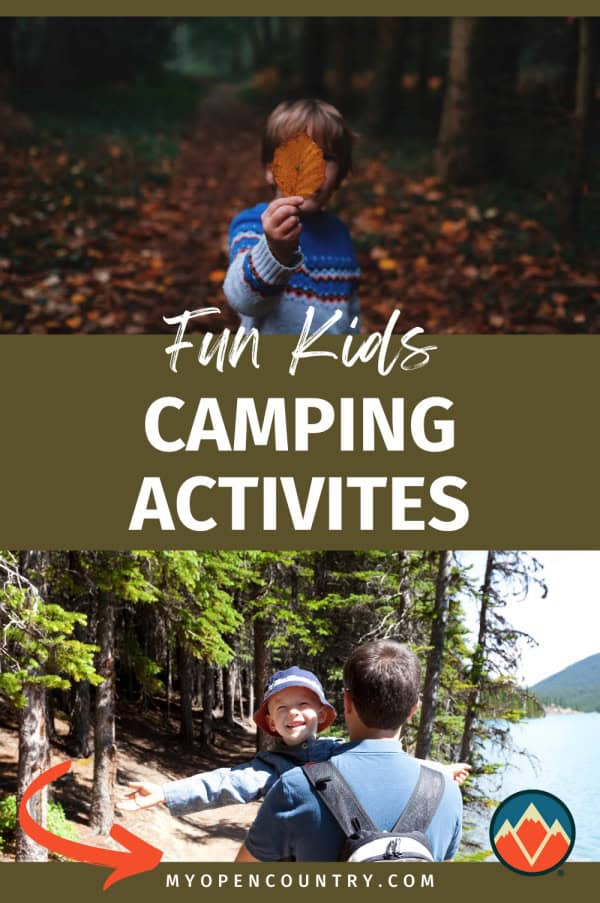
All kids have different interests, of course, so no one list can cover everything your child might be interested in doing. Instead, we’re going to give you a few examples of the kinds of activities you can do and the types of kids who usually enjoy them. Treat these as inspiration, not hard-and-fast rules.
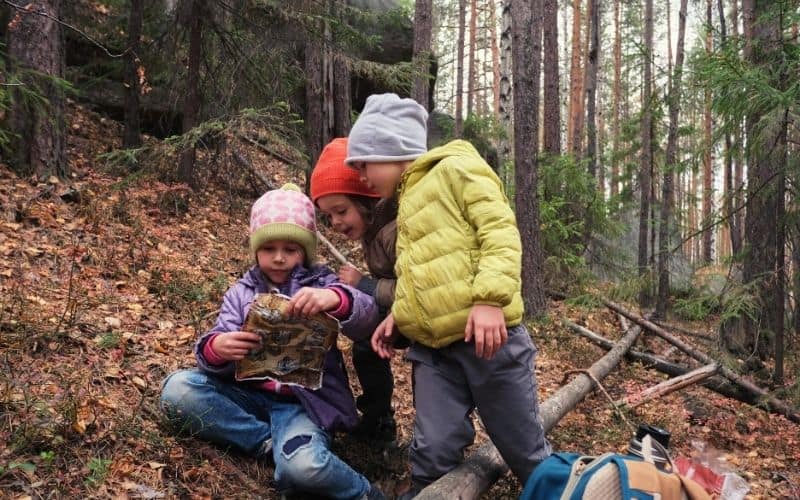
Flashlight Tag
This is ideal for younger kids – especially those with lots of energy. If your campsite has a large, safe area to play – nowhere for ankles to get caught and twisted or broken – give your kiddos flashlights and have them play hide-and-seek at night. Instead of just looking for people, though, they have to shine their light on the target.
Map Making
This is best for kids who love to explore nature and the great outdoors.
Give them a couple of different tools and ask them to create a map of the area. If they’re particularly fond of this activity, make it more challenging by asking them to include certain categories. This could include marking the locations of safe-to-eat plants, showing the best evacuation routes, or even finding wild animal trails.
Bingo
This game is great for kids with a keen eye and inquisitive mind, though it does take some preparation. A good bingo card should have a variety of things to find – some easy, some hard. When creating bingo cards, try calling the camp and asking about the kinds of fun things you can expect to see and create cards from that information.
Camp Songs
If you’re not bothering anyone else, sing away! Teaching songs is a great way to pass the evening by… or just wait until dinner is ready.
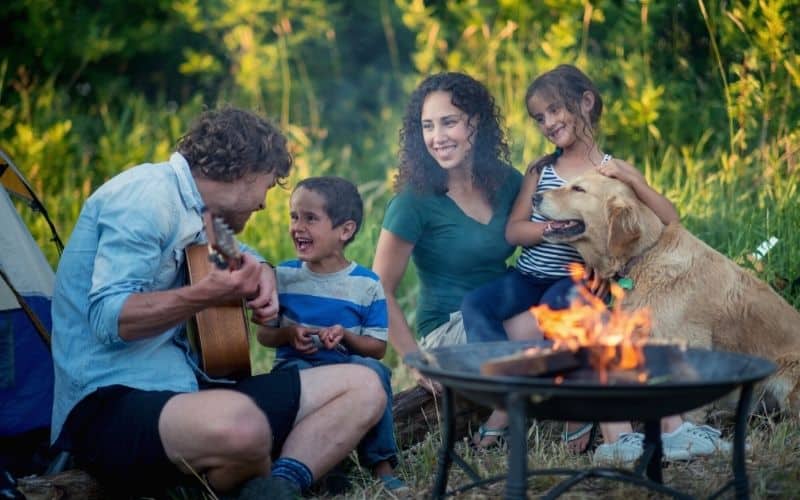
Card Games
A battered old deck of cards can help create hours of fun if you know the rules to a few card games like Go Fish!, Old Maid, or Spoons.
Do’s and Don’ts for a Camping Trip With Kids
Do’s
- Bring all the essentials, such as emergency camping equipment, first-aid gear, and a map and compass.
- Check out reviews for your camping gear before you buy it. If something fails during the trip, it’ll be too late to do anything about it.
- Bring emergency food supplies, such as pre-packaged food like energy bars and dried fruit. Keep these separate from your other camping supplies and, in summer, away from the heat.
- Arrive early in the day. Setting things up can take a while, and this should only be done when you have plenty of light.
- Choose a location close to home for your first camping trip.
- Have fun: This, more than anything else, is the ultimate goal of your trip!
Don’ts
- Eat the same foods all the time, no matter how easy they are to pack. Having a healthy variation in your diet is essential.
- Leave your food unattended. Animals, including bears in some areas, can and will investigate it.
- Leave a footprint (dispose of trash properly, don’t leave fires unattended, etc.). You should always leave the campground as (or better than) you found it.
Fun Times With the Whole Family!
Hopefully, we have helped give you the smarts and confidence to head out and start creating happy memories with your younger family members on your next camping trip. Bear in mind that there’s an element of trial and error to any endeavor in the outdoors, so don’t be disheartened if things don’t go off without a hitch the first time around. Happy camping!
If you enjoyed this post or have any questions, please drop us a line in the comments box below. And if you’d like to share it with your friends, share away!
Save for later! ⤵️
